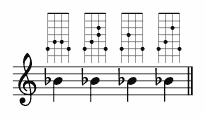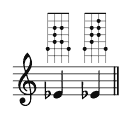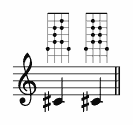
C major
A minor

G major
E minor

D major
B minor

A major
F# minor

E major
C# minor

B major

F# major

C# major

Ab minor

Eb minor

Bb minor

Ab major
F minor

Eb major
C minor

Bb major
G minor

F major
D minor
Introduction | Scales + Arpeggios | Notes | Key Signatures | Alternate Fingerings | Breathing | Tricks | Download
SKIP straight to the scales >>>
Not so long ago I started learning to play the Mountain Ocarina. I started learning some tunes out of the "300 Celtic Folksongs" book, but I also felt that I needed some exercises to help me master all the fingerings and get used to playing in different keys. Also, I have an interest in improvisation. This lead me to write some code to generate a complete set of scales and arpeggios in all the possible keys, with fingerings, for easy reference as I needed them. (Engraving was done with LilyPond.)
Most of the time playing music on an ocarina, you find yourself going up and down a scale of some type: normally the major or minor scale of some key, but sometimes a more exotic scale. So it makes sense to me to practice playing scales in the 3-4 keys that I use most often so that the fingerings come easily. The aim is to play the scale easily FROM MEMORY, without looking at the music or fingering charts. Only then has it been mastered.
I also generated some additional exercises to help in practicing ornamentation and steps of more than one note, again aiming to have these changes come easily whilst playing or improvising. Again, these should be played FROM MEMORY for greatest benefit.
Since a lot of improvisation is based around scales other than the plain major and minor scales, I searched through Wikipedia for all the scales that I could find that use normal Western tuning. Several of these come from other varieties of flute, so are especially suited to the ocarina's sound. These are all shown with fingerings for all the 12 different keys. (There are other Arab scales that it might be possible to play on the ocarina, but only with a lot of experimentation to find fingerings for quarter-semitones and so on.)
Note that scales are pretty pointless in themselves -- they are only the means to an end, which is greater proficiency on the ocarina to play real music or to improvise. Realistically, you're only going ever need a few of these. To help you choose easy keys to improvise in, the scales that are most natural to play on the ocarina are shown in green in the table below, and the most awkward are shown in red. (This is calculated on the basis of the number of finger-changes that the scale requires as you go up and down). There are two versions of these pages, one for the G ocarina and the other for the C ocarina. The reason for this is the difference in the ideal fingering for the B-flat (see below).
All scales start and end on the root note, but to exercise the full range of the ocarina for that scale, the top and bottom notes used in the scale usually aren't the root note. The scale goes up as high as it can then down as low as it can, before returning to the root note.
Below each scale are links to other keys. The colour behind the key-name text is related to how easy the scale is likely to be to play, based on how complicated the finger-changes are. Green is easiest, red is most awkward.
Finding the key from a key-signature:
 C major A minor |
 G major E minor |
 D major B minor |
 A major F# minor |
 E major C# minor |
 B major |
 F# major |
 C# major |
 Ab minor |
 Eb minor |
 Bb minor |
 Ab major F minor |
 Eb major C minor |
 Bb major G minor |
 F major D minor |
There are several sets of alternate fingerings for the Mountain Ocarina.
For B-flat, the first fingering sounds best to me on my polycarbonate C ocarina, but the second sounds best to me on my G ocarina. The official fingering is the last one, which sounds sharp to me on both. (I checked this by playing up and down the F major scale from F to C on both instruments, and also checking with a guitar tuner.) Of course you can adjust the tuning with your breath, so you can compensate to some extent whatever the fingering, and your instrument may be different in any case. However, I had trouble with 'hearing' the wrong note and adjusting up instead of down sometimes when playing scales from the official fingerings, which is why I've included a different set of pages for the C ocarina. The pages for the C ocarina use the first fingering below, and for the G ocarina use the official fingering. Alternative fingering can also be useful to make ornamentation easier:

For E-flat, sometimes in the scales you will see the second fingering, where it is easier in a particular scale:

For C-sharp, the first fingering is always used on the sheets because the second one can't be used on the C ocarina.

I have had some trouble with not getting enough oxygen in my lungs when playing long pieces, especially with the G ocarina which doesn't require much air. Same if I am trying to play whilst walking along -- I get out of breath and have to stop playing to get some oxygen. I got some advice from an experienced woodwind/ recorder/ early-instrument musician. There were a couple of suggestions to try:
As a variation to the previous technique, you can also try loosening your lips and blowing slightly 'around' the ocarina on a long note, which has the same effect. I'm still experimenting with what is best for the ocarina.
There is also circular breathing, which is supposed to be really hard to master, but which lets you blow forever without gaps; it involves storing a bit of air pressure in your mouth to keep the note going, whilst closing the back of the mouth and breathing in through the nose. I have no idea if it would work with the ocarina.
Some tricks with the mountain ocarina:
All these web-pages can be downloaded as a ZIP for you to view on your computer offline. The ZIP also contains the LilyPond source for the music, which you could use to generate PDFs or printouts. It also includes the Perl source for generating the LilyPond files, for any programmers out there.
This work is licenced under a Creative Commons Licence: 